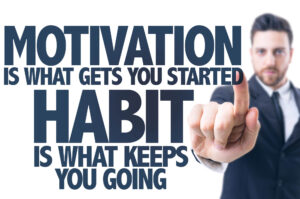Good leadership is defined by the habits that shape the way a leader reacts to situations, interacts with their team, and overcomes challenges daily. While the habits of effective leaders are often studied, the most critical question is not what habits make a good leader; rather, it is how actually to implement better leadership habits into your workday.
What’s the Role of Habits in Leadership?
Habits are a crucial component of business leadership. According to research, up to 40% of our daily behaviors are a result of habit. Essentially, you are what you repeatedly do. Think of your habits as the tracks that the train of your life will follow. It is to a leader’s benefit, then, to ensure that good leadership habits are in place to guide these daily behaviors.
What is the Habit Loop?
In his book The Power of Habit, Charles Duhigg explores the idea of the “habit loop.” His premise is that, according to the science behind habits, people typically have more success in ridding themselves of bad habits if they change or replace those habits with better ones. Every habit, he said, consists of a “loop” of three components: cue, routine, and reward.
The Three Components of the Habit Loop: Cue, Routine, Reward
The cue, in Charles Duhigg’s habit loop, is the trigger that initiates the habit. For bad leadership habits, this may be due to stress, the time of day, exhaustion levels, or specific situations. These less-than-ideal conditions can lead to undesirable habits, such as losing your temper or micromanaging your employees.
Next is the routine. This is the bad habit itself, the one you consistently fall into. For leaders, this could include poor communication, reluctance to delegate, and taking on too many projects, among other issues. The routine is the action you take in response to the cue.
Finally, the reward. Even evil and harmful habits activate the reward center of our brain in some way, typically because they offer a short-term, feel-good solution to the initial problem. The reward could be avoiding discomfort, feeling like you’re in control, or achieving a goal. However, with bad leadership habits, this temporary reward harms us in the long run.
How to Apply the Habit Loop to Leader Habits
This same habit loop can be harnessed to create positive change and instill good habits. If you maintain the same cue and reward, but change the routine and believe in your ability to keep it, you will begin to see better results.
Identifying Cues for Leadership Habits
The first step is to figure out the factors that trigger your bad habits. Becoming aware of what this looks like in your daily life can help you avoid mindlessly reacting when a situation arises.
Modifying Routines to Improve Leadership Behavior
Next, consider how to modify your response to those triggers. What positive habits would you like to see instead? For example, if the cue is an angry email from a client, your new routine might be to set a timer for five minutes to calm down before responding.
Adjusting Rewards for Positive Reinforcement
The rewards for positive habits are often long-term, rather than short-term, so creating positive change may not feel rewarding in the moment. You may need to come up with additional rewards to help encourage your new leadership habits to stick.
Creating a Leadership Culture of Habit Change
As a leader, not only should you examine your habit loops to identify problem behaviors, but you should also encourage your team to do the same. Here’s how you can create a culture of habit change in your workplace.
Encouraging Habit Modification Across the Team
Your employees can’t make changes if they don’t know how. It’s up to the leader to spearhead efforts towards personal growth. Share resources and train employees on habit modification, then help them brainstorm what that might look like in their work life. Normalize discussing how each employee would like to grow and develop.
Leading by Example: Leaders as Habit Role Models
It’s essential to discuss your efforts in habit modification in real-time so that your team has an example to follow. By showcasing both your successes and failures, your employees can feel encouraged that actual change is possible.
Fostering a Growth-Oriented Organizational Culture
Many leaders claim to value constructive change, but in practice, they do not allow for the time and risk that growth requires. Fostering a development-oriented culture means ensuring your team has the time and energy to invest in workshopping their habits. This might mean devoting less time and energy to other priorities; however, it’s necessary if you want to see actual growth.
Great habits make great leaders. Ultimately, the habits you cultivate each day determine the power of your leadership over time. By taking the time to develop consistent behaviors and encouraging your team to do the same, you can foster a workplace culture of reflection, self-awareness, and positive change.
Want to learn more about how to form new habits? Interested in leadership and personal development? Click here to sign up for my weekly articles on the keys to entrepreneurial success.
Coach Dave
- How to Turn Your Problems and Obstacles into Opportunities - September 25, 2025
- Irresistible Tips on How I Can Identify and Create My Unique Small Business Value Proposition - September 18, 2025
- How to Protect Intellectual Property as a Small Business Owner - September 11, 2025


